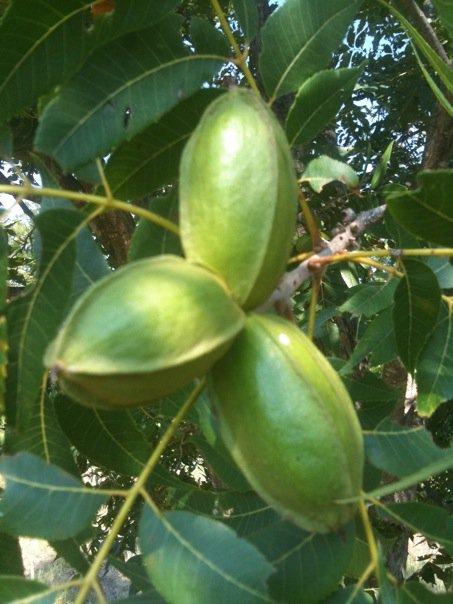
Fred R. Brison, County Agent, San Saba County, San Saba, Texas
Top-working is the removal of the native top of a pecan tree, or a part of
it, and substituting in its place another top, supposedly of a more desirable
and superior variety. It is the transfiguration that takes place in re
moving a pecan tree's native top and causing to grow in its place another top.
It occasionally happens that the transfiguration process results in "disfigurations," however.
The whole process of top-working is not done at one time. To completely top work a pecan tree, it requires one or more years, depending on the
size of the tree in question. It may be accomplished either by budding or
grafting. From two to fifteen or more buds or grafts are required to successfully top-work a pecan tree depending upon its-size and confirmation.
Methods for Top Working Pecan Tree
The early pecan propagators used or attempted to use the methods
P of budding and grafting that were successful in the propagation of the
common fruit and nut trees. The cleft graft was tried and was a commercial failure. The T-or shield-bud was tried and likewise gave unsatisfactory results. The next step in the evolution of a satisfactory method
of propagating pecans was the introduction of the ring bud. If this
method is to be used, small limbs on which to bud are necessary. These
can be had in favorable locations on large trees only by cutting the tree back, or "dehorning" it, causing it to force out a large number of young
shoots.
 The dehorning should be done in the late winter when the pecan trees
The dehorning should be done in the late winter when the pecan trees
are thoroughly dormant. A large number of shoots will form in the spring,
and these will be ready to bud by the last week in July. or the first of
August, ordinarily. The inserted buds will force into growth in the fall
or early the following spring and after then it is just a question of
diverting the pecan tree's energy into the budded shoots and eliminating native
growth. It has now become the general practice to patch-bud the small
native pecan shoots rather than to ring-bud them.
Inlay Bark Graft for Pecans
A second important way to top-work pecan trees is by use of the
bark-graft. This method of propagation is especially adapted to top-
working large trees, and pecan trees that are not in a vigorous, rapid-growing
condition. The best time to top-work a tree by use of the bark graft
is during the early part of the growing season in the spring. Grafts may be inserted in limbs or trunks of trees six inches or less in diameter. It
is a-customary practice to insert two scions in each limb or stock to increase the chances of getting on scion to grow on each stock. In the event
both live only one should be allowed to grow otherwise a weak crotch
will be formed. Bark grafts'make a strong, vigorous growth the first
season..
Pecan Patch Budding Native Pecan Trees
Still a third way of top-working large trees is by inserting buds in the
rough bark of limbs from one-half to two or three inches in diameter.
The patch bud seems to be better adapted to this kind of work than any
other. Healthy, thrifty trees, fifteen inches or less in diameter can be
successfully top-worked in this way. The best time to insert patch buds is
just as soon as the pecan bark will slip freely in the spring. The buds thus have
a longer growing season than when inserted later. Buds may be placed
limbs or stock three inches or less in diameter. It is not necessary
to bud all of the limbs of this size, however. The placing of the buds is
very important select limbs and locate the buds so that the relative shape
and symmetry of the original top will be maintained. Pecan Trees fifteen inches
in diameter require from. Twelve to thirty or forty buds depending on the conformation of the tree's top.
When budding large stock, too much importance can not be attached to the idea of using only large. plump buds. No budder should handicap his
efforts by using inferior or poorly developed buds. Too often the bark of
the"patch "lives but the bud refuses to grow-a case in which the operation is a success but the patient dies. If well-developed buds are not available this year, let the tree go until next year rather than use small and inferior buds.
The job of top-working a large tree is about half complete when it is
budded. The after care and forcing of the buds is of importance equal
to the budding. Often a pecan budder does an excellent piece of work
but unfortunately the man who has the work done does not appreciate the
importance of giving the buds the attention they require, and they do not
grow and thrive as he expects them to. Consequently he is a disappointed pecan enthusiast and a liability to the progress and development of the pecan industry.
For working over thrifty pecan trees less than fifteen inches in diameter the writer favors the patch bud inserted in the rough bark in preference
to all other methods of propagation and systems of ţop-working with which
he is familiar, though he is not unmindful of some specific adaptations and
you have in your work and the attention. You pay to the intricate and
advantages other methods may have. Yet, it matters not so much which
method or system you follow ; of greater importance is the personal interest
minute details involved in inserting a bud or graft.

